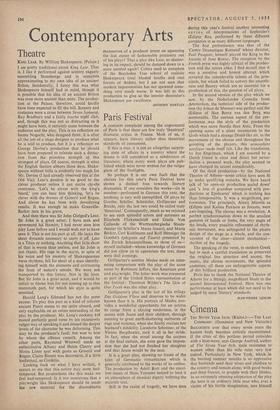Contemporary Arts
Theatre
KIM LEAR. By William Shakespeare. (Palace.) I AM pretty traditional about King Lear. That is, I like it performed against scenery vaguely resembling Stonehenge and in costumes approximating to my own idea of an ancient Briton. Incidentally, I fancy this was what Shakespeare himself had in mind, though it is possible that his idea of an ancient Briton was even more ancient than mine. The produc- tion at the Palace, therefore, could hardly have been expected to fill the bill. Scenery and costumes were a cross between Seven Samurai, Ray Bradbury and a fairly louche night club, and, though this was not as distracting as it might have been, it certainly came between the audience and the play. This is no reflection on Isamu Noguchi, who designed them; it is after all the job of a stage designer to produce what he is told to produce, but it is a reflection on George Devine's production that he should have been prepared to tolerate such a detrac- tion from the primitive strength of this strongest of plays. Of course, strength is what the English theatre abhors these days. Shake- speare without frills is evidently too much for Mr. Devine (I had already observed this at the Old Vic); Lear's pasgion is no good to the clever producer unless it can excite chi-chi overtones. 'Let's be clever with the king's beard,' you can hear him thinking, 'let's be clever with the dresses of Goneril and Regan. And clever he has been with devastating results. It was enough to make Granville- Barker turn in his grave.
And then there was Sir John Gielgud's Lear. Sir John is a great actor; I have seen and reverenced h,is Hamlet; I had never seen him play Lear before and I would wish not to have seen it. This is not his part at all. He lacks the sheer dynamic necessary to carry it off. Lear is a Titan or nothing. Anything that falls short of that is worse than useless, and Sir John is not titanic. His rage in the storm, in spite of his voice and his mastery of Shakespearean verse rhythms, fell far short of a man identify- ing himself with the elements and celebrating the feast of nature's unrule. We were not transported by this frenzy. Not in the least. But Sir John is a great actor, and it would be unfair to blame him for not coming up to this mammoth part, for which his style is quite unsuited.
Harold Lang's Edmund has not the same excuse. To play this part as a kind of inferior ancient Pistol seems to me quite absurd, and only explicable on an entire misreading of the play by the producer. Mr. Lang's cockney kid ruined perfectly good verse by his excessively vulgar way of speaking it and missed the deeper levels of the character he was deforming. This may be the producer's fault; but woe to him by whom the offence cometh. Among the other parts, Raymond Westwell made an authoritative Albany and Helen Cherry and Moira Lister spat with gusto as Goneril and Regan. Claire Bloom was decorative, if a little ineffectual, as Cordelia.
Looking back on what I have written, it occurs to me that this notice may seem bad- tempered. But productions like this make me feel bad-tempered. Is it not monstrous that a playwright like Shakespeare should be made the raw material for the discreditable manoeuvres of a producer intent on squeezing the last ounce of fashionable preciosity out of his plays? That a play like Lear, so shatter- ing in its impact, should be damped down to a mere scented squib? Critics used to complain of the Beerbohm Tree school of realistic Shakespeare (real blasted heaths and real forests of Arden), but I am not sure that modern impressionism has not spawned some- thing very much worse. It was left to this production to give us the interior decorator's Shakespeare par excellence.
ANTHONY HARTLEY


































 Previous page
Previous page